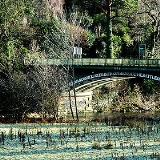
Waterloo Bridge, Betws-y-Coed
Encyclopedia
Waterloo Bridge is an early cast iron
bridge
, spanning the River Conwy
at Betws-y-Coed
, in Conwy county borough, north-west Wales
.
The bridge is located about half a mile south-east of the village. It was built by the civil engineer Thomas Telford
. An inscription on the arch records that it was constructed in the year of the Battle of Waterloo
: but although designed and constructed in 1815 its erection was not completed that year. It was raised as part of building the road from London to Holyhead (now the A5). The bridge is made wholly from cast iron
(apart from the stone bastions) and was only the seventh such bridge to be built.
Cast iron
Cast iron is derived from pig iron, and while it usually refers to gray iron, it also identifies a large group of ferrous alloys which solidify with a eutectic. The color of a fractured surface can be used to identify an alloy. White cast iron is named after its white surface when fractured, due...
bridge
Bridge
A bridge is a structure built to span physical obstacles such as a body of water, valley, or road, for the purpose of providing passage over the obstacle...
, spanning the River Conwy
River Conwy
The River Conwy is a river in north Wales. From its source to its discharge in Conwy Bay it is a little over long. "Conwy" is sometimes Anglicized as "Conway."...
at Betws-y-Coed
Betws-y-Coed
Betws-y-Coed is a village and community in the Conwy valley in Conwy County Borough, Wales. It has a population of 534. The name Betws or Bettws is generally thought to be derived from the Anglo-Saxon Old English 'bed-hus' - i.e. a bead-house - a house of prayer, or oratory...
, in Conwy county borough, north-west Wales
Wales
Wales is a country that is part of the United Kingdom and the island of Great Britain, bordered by England to its east and the Atlantic Ocean and Irish Sea to its west. It has a population of three million, and a total area of 20,779 km²...
.
The bridge is located about half a mile south-east of the village. It was built by the civil engineer Thomas Telford
Thomas Telford
Thomas Telford FRS, FRSE was a Scottish civil engineer, architect and stonemason, and a noted road, bridge and canal builder.-Early career:...
. An inscription on the arch records that it was constructed in the year of the Battle of Waterloo
Battle of Waterloo
The Battle of Waterloo was fought on Sunday 18 June 1815 near Waterloo in present-day Belgium, then part of the United Kingdom of the Netherlands...
: but although designed and constructed in 1815 its erection was not completed that year. It was raised as part of building the road from London to Holyhead (now the A5). The bridge is made wholly from cast iron
Cast iron
Cast iron is derived from pig iron, and while it usually refers to gray iron, it also identifies a large group of ferrous alloys which solidify with a eutectic. The color of a fractured surface can be used to identify an alloy. White cast iron is named after its white surface when fractured, due...
(apart from the stone bastions) and was only the seventh such bridge to be built.

